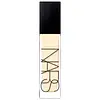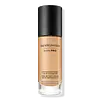NARS Cosmetics Natural Radiant Longwear Foundation Versus bareMinerals Barepro Performance Wear Liquid Foundation SPF 20
What's inside
What's inside
 Key Ingredients
Key Ingredients

 Benefits
Benefits

 Concerns
Concerns

 Ingredients Side-by-side
Ingredients Side-by-side

Dimethicone
EmollientWater
Skin ConditioningPhenyl Trimethicone
Skin ConditioningGlycerin
HumectantPolymethylsilsesquioxane
PEG-10 Dimethicone
Skin ConditioningDimethicone Crosspolymer
Emulsion StabilisingCyclopentasiloxane
EmollientTrimethylsiloxysilicate
EmollientPPG-3 Benzyl Ether Myristate
EmollientBoron Nitride
AbsorbentBis-Butyldimethicone Polyglyceryl-3
CleansingButylene Glycol
HumectantCitrullus Lanatus Fruit Extract
Skin ConditioningPyrus Malus Fruit Extract
Skin ConditioningLens Esculenta Fruit Extract
Skin ConditioningTocopherol
AntioxidantRubus Idaeus Fruit Extract
AstringentSorbitan Sesquiisostearate
EmulsifyingHydrogenated Polydecene
EmollientDisteardimonium Hectorite
StabilisingBehenyl Alcohol
EmollientCI 77120
Cosmetic ColorantTriethoxycaprylylsilane
Aluminum Dimyristate
Emulsion StabilisingDisodium Stearoyl Glutamate
CleansingPentaerythrityl Tetraethylhexanoate
EmollientBehenic Acid
CleansingStearic Acid
CleansingSodium Stearoyl Glutamate
CleansingStearyl Alcohol
EmollientSodium Lactate
BufferingPotassium Hydroxide
BufferingTin Oxide
AbrasiveSodium PCA
HumectantAlumina
AbrasiveSodium Benzoate
MaskingPentaerythrityl Tetra-Di-T-Butyl Hydroxyhydrocinnamate
AntioxidantPEG/PPG-14/7 Dimethyl Ether
Skin ConditioningPolysilicone-2
Phenoxyethanol
PreservativeCaprylyl Glycol
EmollientCI 77491
Cosmetic ColorantCI 77492
Cosmetic ColorantCI 77499
Cosmetic ColorantMica
Cosmetic ColorantCI 77891
Cosmetic ColorantDimethicone, Water, Phenyl Trimethicone, Glycerin, Polymethylsilsesquioxane, PEG-10 Dimethicone, Dimethicone Crosspolymer, Cyclopentasiloxane, Trimethylsiloxysilicate, PPG-3 Benzyl Ether Myristate, Boron Nitride, Bis-Butyldimethicone Polyglyceryl-3, Butylene Glycol, Citrullus Lanatus Fruit Extract, Pyrus Malus Fruit Extract, Lens Esculenta Fruit Extract, Tocopherol, Rubus Idaeus Fruit Extract, Sorbitan Sesquiisostearate, Hydrogenated Polydecene, Disteardimonium Hectorite, Behenyl Alcohol, CI 77120, Triethoxycaprylylsilane, Aluminum Dimyristate, Disodium Stearoyl Glutamate, Pentaerythrityl Tetraethylhexanoate, Behenic Acid, Stearic Acid, Sodium Stearoyl Glutamate, Stearyl Alcohol, Sodium Lactate, Potassium Hydroxide, Tin Oxide, Sodium PCA, Alumina, Sodium Benzoate, Pentaerythrityl Tetra-Di-T-Butyl Hydroxyhydrocinnamate, PEG/PPG-14/7 Dimethyl Ether, Polysilicone-2, Phenoxyethanol, Caprylyl Glycol, CI 77491, CI 77492, CI 77499, Mica, CI 77891
Water
Skin ConditioningCyclopentasiloxane
EmollientTrimethylsiloxysilicate
EmollientButylene Glycol
HumectantSilica
AbrasivePEG-10 Dimethicone
Skin ConditioningBis-Butyldimethicone Polyglyceryl-3
CleansingBambusa Arundinacea Stem Extract
Skin ConditioningSodium Glutamate
MaskingDisteardimonium Hectorite
StabilisingSorbitan Sesquiisostearate
EmulsifyingHydrogenated Lecithin
EmulsifyingMethicone
EmollientPapain
Skin ConditioningAluminum Hydroxide
EmollientStearic Acid
Cleansing1,2-Hexanediol
Skin ConditioningCaprylyl Glycol
EmollientCarbomer
Emulsion StabilisingAlgin
MaskingTocopherol
AntioxidantSodium Dehydroacetate
PreservativePhenoxyethanol
PreservativeTitanium Dioxide
Cosmetic ColorantIron Oxides
Water, Cyclopentasiloxane, Trimethylsiloxysilicate, Butylene Glycol, Silica, PEG-10 Dimethicone, Bis-Butyldimethicone Polyglyceryl-3, Bambusa Arundinacea Stem Extract, Sodium Glutamate, Disteardimonium Hectorite, Sorbitan Sesquiisostearate, Hydrogenated Lecithin, Methicone, Papain, Aluminum Hydroxide, Stearic Acid, 1,2-Hexanediol, Caprylyl Glycol, Carbomer, Algin, Tocopherol, Sodium Dehydroacetate, Phenoxyethanol, Titanium Dioxide, Iron Oxides
 Reviews
Reviews

Ingredients Explained
These ingredients are found in both products.
Ingredients higher up in an ingredient list are typically present in a larger amount.
Bis-Butyldimethicone Polyglyceryl-3 is a type of silicone.
Butylene Glycol (or BG) is used within cosmetic products for a few different reasons:
Overall, Butylene Glycol is a safe and well-rounded ingredient that works well with other ingredients.
Though this ingredient works well with most skin types, some people with sensitive skin may experience a reaction such as allergic rashes, closed comedones, or itchiness.
Learn more about Butylene GlycolCaprylyl Glycol is a humectant and emollient, meaning it attracts and preserves moisture.
It is a common ingredient in many products, especially those designed to hydrate skin. The primary benefits are retaining moisture, skin softening, and promoting a healthy skin barrier.
Though Caprylyl Glycol is an alcohol derived from fatty acids, it is not the kind that can dry out skin.
This ingredient is also used as a preservative to extend the life of products. It has slight antimicrobial properties.
Learn more about Caprylyl GlycolCyclopentasiloxane, or D5, is a silicone used to improve texture of products and trap moisture.
D5 is considered lightweight and volatile. Volatile means it evaporates quickly after application. Once evaporated, D5 leaves a thin barrier that helps keep skin hydrated.
It is also an emollient. Emollients help soften the skin and prevent water loss. Silicones create a silky texture in products. D5 helps other ingredients become more spreadable.
Studies show D5 is safe to use in skincare products. We recommend speaking with a skincare professional if you have concerns.
Learn more about CyclopentasiloxaneDisteardimonium Hectorite comes from the clay mineral named hectorite. It is used to add thickness to a product.
It can also help stabilize a product by helping to disperse other ingredients.
Hectorite is a rare, white clay mineral.
Learn more about Disteardimonium HectoritePeg-10 Dimethicone is silicone with conditioner and emulsifier properties. It mostly acts as an emollient in skincare and and humectant in haircare.
According to the manufacturer, acidic formulations decrease the stability of this ingredient. It works best in neutral or near neutral formulations.
Phenoxyethanol is a preservative that has germicide, antimicrobial, and aromatic properties. Studies show that phenoxyethanol can prevent microbial growth. By itself, it has a scent that is similar to that of a rose.
It's often used in formulations along with Caprylyl Glycol to preserve the shelf life of products.
Sorbitan Sesquiisostearate isn't fungal acne safe.
Stearic Acid is a fatty acid. It is an emollient, emulsifier, and texture enhancer.
As an emollient, stearic acid helps soften skin. It aids the skin's protective barrier by preventing water loss. It also provides a gentle cleansing effect without stripping away natural oils.
Stearic acid may also be used to enhance the texture of products. It can add volume and stabilize ingredients such as water and oil. This can help water and oil ingredients from separating.
Sources of stearic acid include animal or vegetable fats/oils such as coconut or shea. It can be naturally found in butter, cocoa butter, shea butter, vegetable fats, and animal tallow.
This ingredient may not be Malassezia folliculitis, or fungal-acne safe.
Learn more about Stearic AcidTocopherol (also known as Vitamin E) is a common antioxidant used to help protect the skin from free-radicals and strengthen the skin barrier. It's also fat soluble - this means our skin is great at absorbing it.
Vitamin E also helps keep your natural skin lipids healthy. Your lipid skin barrier naturally consists of lipids, ceramides, and fatty acids. Vitamin E offers extra protection for your skin’s lipid barrier, keeping your skin healthy and nourished.
Another benefit is a bit of UV protection. Vitamin E helps reduce the damage caused by UVB rays. (It should not replace your sunscreen). Combining it with Vitamin C can decrease sunburned cells and hyperpigmentation after UV exposure.
You might have noticed Vitamin E + C often paired together. This is because it is great at stabilizing Vitamin C. Using the two together helps increase the effectiveness of both ingredients.
There are often claims that Vitamin E can reduce/prevent scarring, but these claims haven't been confirmed by scientific research.
Learn more about TocopherolThis silicone is an emollient. Emollients create a thin film on the skin to prevent moisture from escaping.
It is not soluble in water and helps increase water-resistance in products.
According to a manufacturer, it can blend seamlessly with silicone oils, such as Cyclopentasiloxane.
Learn more about TrimethylsiloxysilicateWater. It's the most common cosmetic ingredient of all. You'll usually see it at the top of ingredient lists, meaning that it makes up the largest part of the product.
So why is it so popular? Water most often acts as a solvent - this means that it helps dissolve other ingredients into the formulation.
You'll also recognize water as that liquid we all need to stay alive. If you see this, drink a glass of water. Stay hydrated!
Learn more about Water